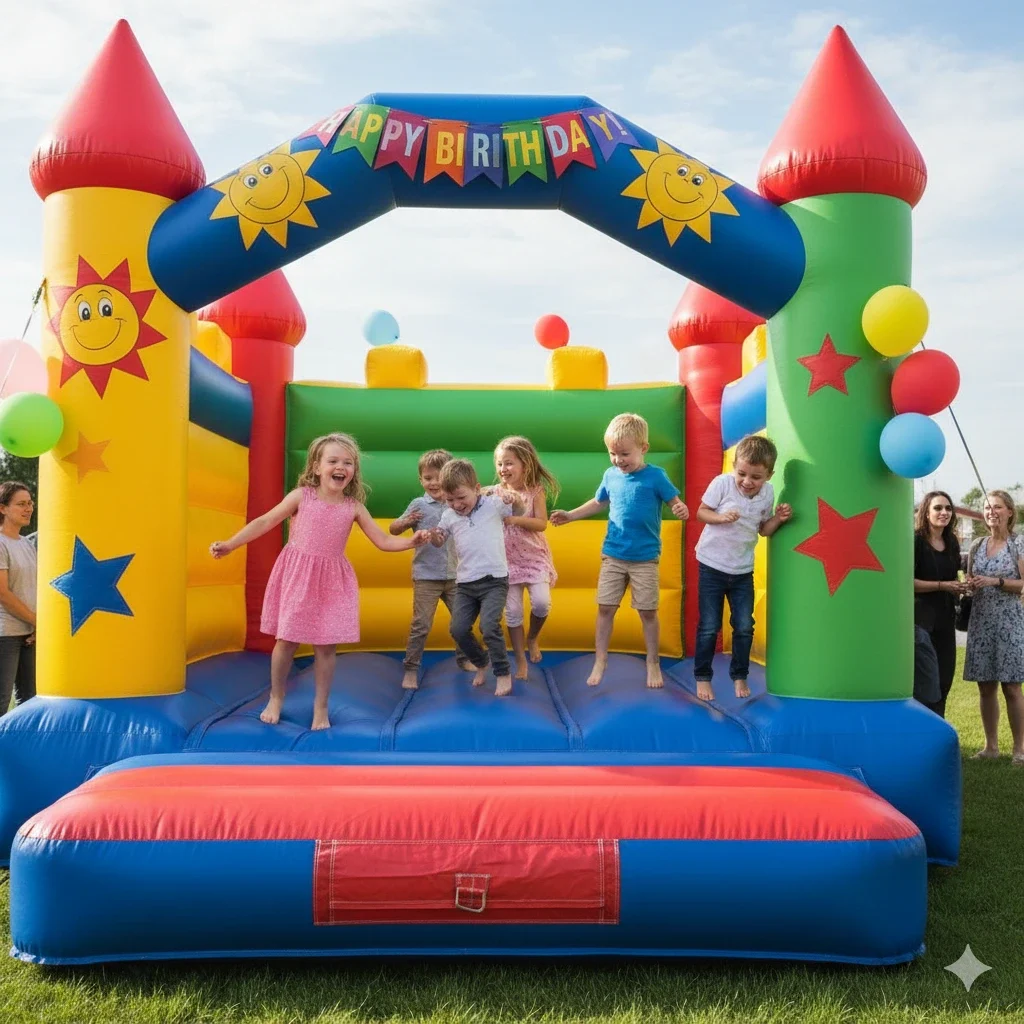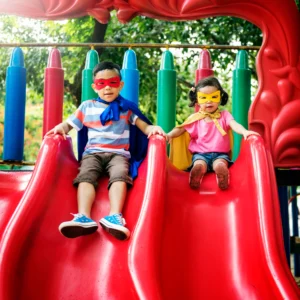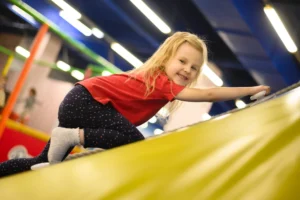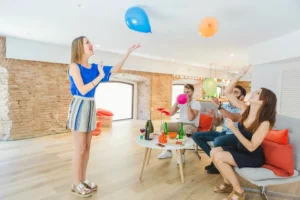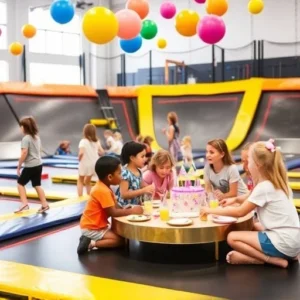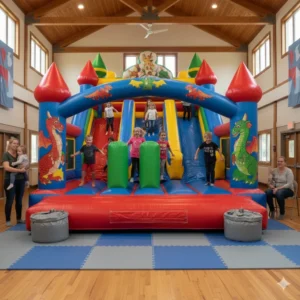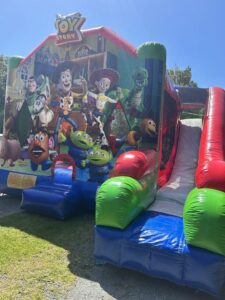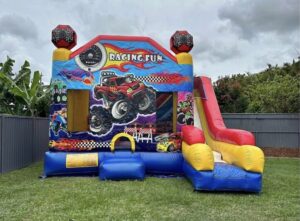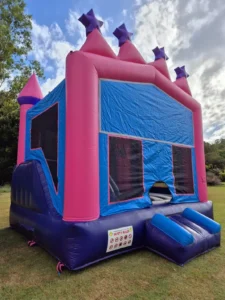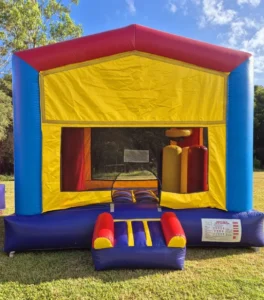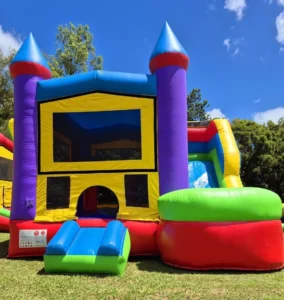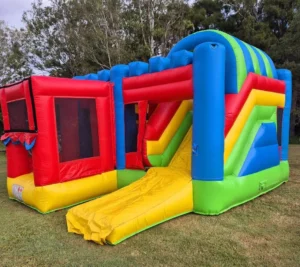Finding the perfect bounce house for your kids’ party can feel both exciting and overwhelming. After all, you want something fun, safe, and age-appropriate. Good news, this process is often easier than it seems. Experts expect the global bounce house market to climb from USD 4.2 billion in 2024 to around USD 6.2 billion by 2034 (Global Market Insights Inc.), which means there are plenty of options out there to suit your family’s needs. In this article, we’ll walk you through essential facts about bounce houses ,sometimes called bouncy castles or inflatables, explore key safety features, and help you decide if renting or buying is the best route for your next party.
Understand bounce house basics
A bounce house is an inflatable play structure typically made of strong fabric or vinyl material. It’s designed for children (and sometimes adults) to jump, slide, and enjoy active play. Many bounce houses come with extra features such as water slides or obstacle courses. If you have an energetic child, a bounce house can be a fantastic way to help them meet the American Academy of Pediatrics’ recommendation of 60 minutes of physical activity each day.
In general, manufacturers recommend bounce houses for children ages 3 through 10. Under-threes are not encouraged to use a standard outdoor bounce house because safeguarding toddlers who are still mastering balance is trickier. According to some guidelines, common bounce house features include:
- Sturdy, reinforced netting or walls to keep children from falling out
- Properly sealed seams to prevent air leaks
- Commercial-grade vinyl or heavy-duty nylon for durability
- Anchoring loops or stake points to secure the unit safely
Interestingly, the first air-inflated structures were developed in 1959 by John Scurlock, who noticed his employees having fun jumping on inflatable covers meant for tennis courts. Over time, sides were added for safety, and by the late 1960s, these inflatable amusements evolved into what we now call bounce houses or bouncy castles. Today’s versions come in all shapes, from small backyard inflatables to giant commercial units that can handle groups of kids at large festivals.
Pick the right size for your party
Not all bounce houses are equal when it comes to dimensions. You will find smaller, toddler-friendly models that measure roughly 6 ft by 6 ft, plus much larger commercial-grade versions spanning 15 ft or more on each side. How do you pick the best size for your kids’ party?
Look at your available space
- Measure your backyard or indoor venue to confirm the footprint you can accommodate.
- Plan for at least a few feet of clearance around the bounce house for safe entry and exit.
Think about the number of children
- Most standard bounce houses safely accommodate 4–6 kids at one time.
- Consider if you expect a big crowd. If so, a bigger unit can help reduce wait times and possible overcrowding.
Match it to your kids’ age
- Younger children benefit from smaller inflatables with lower walls to help them climb in and out.
- Older kids (about 8 and up) often appreciate taller bounce houses with slides or obstacle elements for more engagement.
Review material quality
- Premium units use high-quality materials like Dura-Lite™ Vinyl. This material is extra durable while staying lighter than older fabrics, making setup easier.
- Aim for a commercial-grade bounce house if you want something that endures frequent use.
Once you’ve figured out which size and design you need, your event setup will go much more smoothly. Paying attention to these details early on sets you up for a safer, more enjoyable party.
Balance Safety Features with Fun
A bounce house can be the highlight of any kid’s party, offering a fun, energetic way for children to spend time together and stay active. However, creating a thrilling atmosphere shouldn’t come at the expense of safety. With a little planning and attention to detail, you can strike the perfect balance between fun and security. By following essential safety guidelines, you’ll ensure that the children are having a blast without the risk of mishaps.
Prioritize Adult Supervision
- Never leave children unattended while they bounce.
- Having at least one or two adults within arm’s reach, especially for younger kids, helps prevent accidental collisions or roughhousing beyond what the structure can handle.
- Set up a rotation system for adult supervision to keep things fresh and manage the group effectively.
Check Wind and Weather Conditions
- Wind speeds over 15 mph significantly increase the risk of the bounce house shifting or toppling.
- If gusts exceed 20 mph, immediately turn off the blower and wait until conditions improve.
- Heavy rain can cause slips, falls, and water damage, so stop bouncing until the weather clears.
- Always check the forecast before setting up and stay aware of sudden weather changes.
Inspect Regularly
- Loose Anchoring Stakes: Ensure the bounce house is securely anchored to the ground to prevent shifting or tipping.
- Torn Netting: Look for any tears or rips in the netting, which can pose a safety risk.
- Deflated Spots Along Seams: Ensure the bounce house is fully inflated, checking for uneven inflation or any fabric issues.
- For heavy or commercial use, schedule regular professional inspections, at least once a month, to spot any potential problems early.
- If renting, do a quick inspection upon delivery to confirm the unit is in good shape.
Manage Capacity
- Place children of similar weights together to prevent uneven bouncing and accidents.
- Never overcrowd the bounce house. Typically, no more than 4–6 children should be inside at a time, depending on the size.
- Rotate children in and out in groups to ensure everyone has a turn without overloading the unit.
Use the Right Anchors
- Secure the bounce house using heavy-duty stakes or sandbags to anchor it in all designated tie-down loops.
- Properly anchor the unit before use, especially when set up outdoors.
- Avoid moving the bounce house after it’s been staked, as improper re-securing can create safety risks.
Quick Safety Tips
- Remove Sharp Items: Ensure children take out any sharp items like keys, pens, or hair clips from their pockets before entering.
- No Shoes, Food, or Drinks: Shoes can damage the surface and increase slip risks, while food and drinks may cause spills.
- Avoid Silly String: It can damage the fabric of the bounce house, so leave it outside the play area.
- Monitor Wind Gusts: Keep an eye on weather changes and wind speeds to prevent instability.
Creating a fun and safe environment for children to play in a bounce house requires careful attention to detail. By prioritizing adult supervision, checking weather conditions, performing regular inspections, managing capacity, and anchoring properly, you can ensure a safe experience that still feels like an adventure. With these simple precautions, you’ll help kids have the time of their lives without compromising on safety.
Rent or buy: Which option wins?
A bounce house can be a major investment, so deciding between renting and buying is a big step. If you anticipate using one several times a year, maybe for birthdays, holiday weekends, or neighborhood gatherings, purchasing might be more cost-effective. On the other hand, if you only need it once or twice, renting can be more convenient, and it saves storage space.
Here’s a quick comparison:
| Factor | Renting | Buying |
| Upfront cost | Low initial cost, but recurring fees if you rent multiple times | Higher initial cost, but usually cheaper than repeated rentals in the long run |
| Maintenance | The rental company handles cleaning and repairs | You must clean, inspect, and repair as needed |
| Storage | No storage needed | You need space to store the folded inflatable, plus possible protective covers |
| Variety | You can switch styles or themes each time you rent (rent a jumping castle near me) | You pick one design you’ll use repeatedly |
| Convenience | Typically delivered and set up by the rental company | You can use it on short notice, but you handle setup and takedown yourself |
If you appreciate having a bounce house ready to go at any moment, or you’re confident you’ll use it more than twice a year, purchasing can pay off. Many parents find that the ability to bounce anytime is worth the upfront cost. If you’re short on storage space or you’d like to cycle through different themes, renting is a good alternative.
Feel free to check local party suppliers or online listings for specialized bouncy castles. You can also look at your city’s stability in terms of inflatables, sometimes searching for “rent a jumping castle near me” reveals surprising options that fit your budget and party theme.
How to Maintain and Set Up Your Bounce House
When you own a bounce house, proper maintenance is crucial not only for safety but also to ensure that your investment lasts for years. Even if you rent one, it’s important to maintain it well by giving it a quick wipe-down before and after each use. Keeping your bounce house in good shape will help preserve its fabric, functionality, and overall safety for everyone who enjoys it. Here’s how you can maintain and set up your bounce house effectively.
Clean Regularly
- One of the easiest and most important steps in maintaining your bounce house is regular cleaning. After each use, wipe down all surfaces with a mild, non-abrasive cleaner. This is especially important if children have eaten snacks or spilled drinks nearby. These residues can create stains or attract dirt, which can degrade the surface of the bounce house over time.
- Pay extra attention to the corners and crevices where grime, dust, and food particles can easily accumulate. It’s easy to overlook these areas, but they are often the places where dirt builds up the fastest. Regular cleaning prevents the growth of bacteria, mold, or mildew, which could be harmful to kids.
- Make sure to use a cleaner that is safe for vinyl or the specific material your bounce house is made of. Avoid harsh chemicals, as they may damage the fabric and weaken the structure.
Store It Dry
- Moisture is one of the main enemies of bounce houses. When left damp, bounce houses can develop mildew, mold, and other forms of degradation that will shorten their lifespan. To prevent this, always make sure that your bounce house is completely dry before storing it.
- After use, if the bounce house is inflated, leave it up for a while to air dry. If it’s deflated, hang it up or lay it flat in a well-ventilated area to allow all moisture to evaporate. If your area is particularly humid, consider using a fan or dehumidifier to speed up the drying process.
- Store your bounce house in a cool, dry location, away from direct sunlight or heat sources. The sun’s rays and extreme temperatures can weaken the material over time, causing it to fade or crack. A dry, shaded area like a garage or storage shed is ideal.
Perform Quick Checks
- Before each use, it’s essential to perform quick checks to ensure that everything is in working order. Inspect the blowers or air pumps for any potential blockages or malfunctions. Blocked airways can prevent the bounce house from inflating properly, and a malfunctioning blower can lead to safety hazards.
- Look for weakened seams, rips, or punctures in the fabric. Even small tears can quickly worsen if left untreated. Regular inspection helps catch potential issues before they become big problems. Also, make sure that all anchor loops are intact and securely fastened. Missing or damaged anchor loops can make it difficult to properly secure the bounce house, leading to safety risks.
Follow Weight and Safety Guidelines
- Bounce houses are designed to hold a certain number of people, typically based on their size and weight capacity. Always follow the manufacturer’s recommended weight and occupancy limits to prevent accidents. Overcrowding the bounce house can lead to wear and tear on the fabric, as well as increase the risk of injury due to improper bouncing conditions.
- It’s also a good idea to post simple, easy-to-follow rules near the entrance. These rules should outline the appropriate behavior for those using the bounce house. For example, you might specify that only one person should jump at a time or that no flips or roughhousing are allowed. Posting these guidelines ensures that guests understand the bounce etiquette, helping to prevent accidents.
Consider Indoor Setup
- If you’re looking for a way to extend the life of your bounce house and enjoy it year-round, consider setting it up indoors. A basement, garage, or gym can be a great location for indoor bounce house fun. However, even when setting up indoors, securing the bounce house properly is still important. Indoor spaces often lack the open area that outdoor setups have, so make sure to anchor it securely to prevent any movement or tipping.
- For tips on how to properly anchor a bounce house indoors, check the manufacturer’s recommendations. Some bounce houses may require specific types of anchors, even when used inside.
Maintaining your bounce house is not necessarily complicated, but it does require consistency. Regular cleaning, proper drying, and regular checks help keep your bounce house in good working condition and ensure that it lasts. Treating your bounce house like a piece of gym equipment with care and attention can extend its lifespan and provide years of enjoyment. Whether used for parties, family gatherings, or just for fun, a well-maintained bounce house will continue to bring joy and excitement to everyone who uses it.
Enjoy a safe, energetic party
When planning your kids’ party, choosing the best bounce house is key to blending fun and safety. A bounce house can create endless entertainment while keeping kids active, but it’s essential to make safety a priority. Start by selecting an age-appropriate size for the bounce house. Consider how many children will be using it, their ages, and the available space in your yard or event venue. Ensuring the size is right for the number of kids helps prevent overcrowding, which can lead to accidents or strain on the structure.
Weather conditions play a significant role in bounce house safety. Always check the forecast before setting up, and monitor weather patterns during the event. High winds and heavy rain can create hazardous conditions, so be ready to pause play if necessary. Securely anchoring the bounce house is another crucial step. Proper anchoring prevents the bounce house from shifting or toppling over.
Regular inspections before each use are also vital. Check for any tears, loose seams, or damaged components to ensure the unit is in safe condition. Clear rules, such as no roughhousing or overcrowding, should be communicated to all children, and adult supervision is a must at all times.
Whether you rent or buy, make sure the bounce house fits your space, budget, and party needs. With thoughtful planning and attention to safety, your event will be filled with laughter, fun, and lasting memories.
Ready to Bounce? Book Your Castle Today!
Bring unforgettable joy to your next event. Free delivery, easy setup, and zero deposit needed. Whether you’re planning a backyard birthday, school fair, daycare learning activities, or neighborhood party, our safe, colorful jumping castles are waiting.
Choose from popular options like our Rainbow Combo, Monster Truck Combo, or Jungle Obstacle Course for endless fun!
Serving Gold Coast, Logan & Beaudesert, plus Northern NSW with competitive delivery charges. Contact us now or submit your booking in just seconds!
Frequently asked questions
1. How much is a bounce house rental?
The cost to rent a bounce house typically ranges from $100 to $350 for a standard 4- to 6-hour rental. Prices vary depending on factors like size, features, and location. Additional charges may apply for delivery, setup, or any special features such as slides, interactive elements, or themes.
- How much is a bounce house?
The price of a bounce house typically ranges from $200 to $1,000 or more, depending on factors like size, material, and whether it’s designed for residential or commercial use. Larger, higher-quality models or commercial-grade bounce houses will generally cost more due to durability and added features.
- How much is it to rent a bounce house near me?
Renting a bounce house near you typically costs between $120 and $300 for a few hours. However, local rates can vary depending on demand, location, and any add-ons like delivery, setup, or special features. It’s best to check with nearby rental companies for exact pricing.
- Where can I rent a bounce house?
You can rent a bounce house from local party rental companies, online platforms such as Thumbtack or RentalHQ, or through event planning services that offer inflatable rentals. Many rental companies also have websites where you can browse options, get quotes, and book directly. Be sure to check availability and reviews for the best options.
5. How long can you rent a bounce house for?
Most bounce house rentals typically last between 4 to 8 hours, providing plenty of time for kids to enjoy. However, many rental companies offer the option to extend the rental for a full day or even overnight for an additional fee. It’s a great option if you want to maximize fun or need more flexibility with timing. Be sure to check with the rental company for specific details and extra charges.
Key Takeaways
- Bounce house basics: Designed for kids aged 3–10, bounce houses provide a fun and safe way for children to engage in physical activity. With proper supervision, they offer a great outlet for energy and exercise. Always ensure that the kids are using the unit safely.
- Size matters: When choosing a bounce house, consider the available space, the number of children who will be using it, and the age group. Opt for a size that comfortably fits within your designated area and is suitable for the kids’ ages to avoid overcrowding and ensure safety.
- Safety first: Supervision is crucial when children are playing in a bounce house. Always have an adult or two nearby to prevent rough play and accidents. Make sure the bounce house is anchored securely, and regularly check for wind or weather changes that could impact safety. Never allow play during unsafe weather conditions like high winds or heavy rain.
- Rent vs. buy: Renting a bounce house is a cost-effective solution for one-off events or occasional use, while buying makes sense for frequent use or large gatherings. If you plan to use it often, investing in a high-quality bounce house can save money in the long run.


